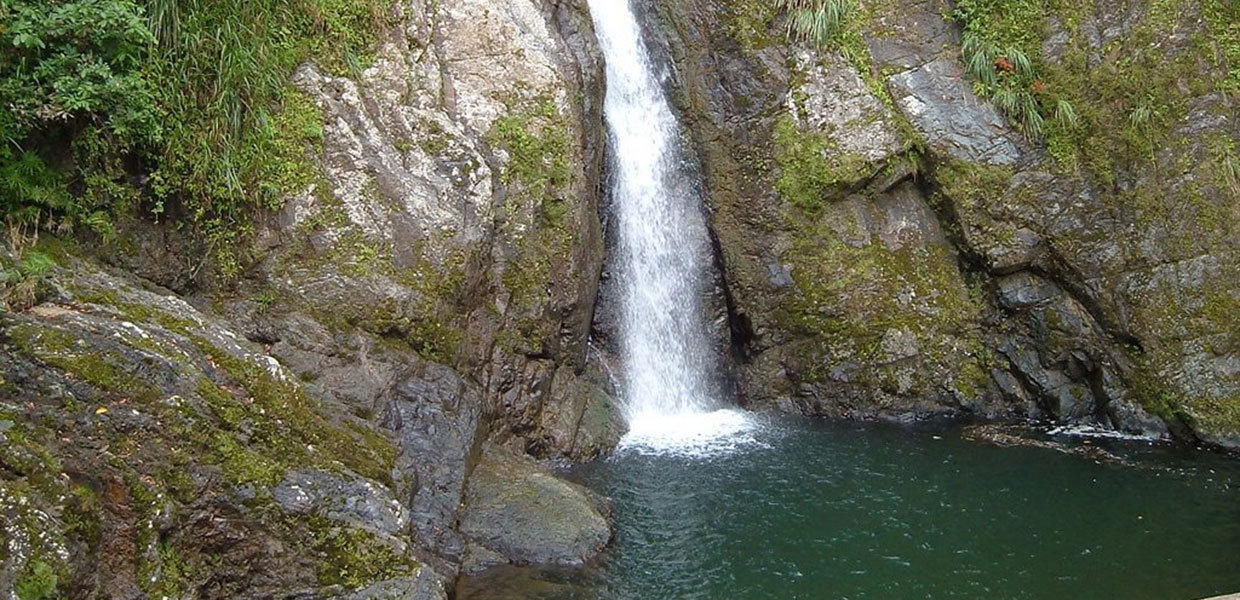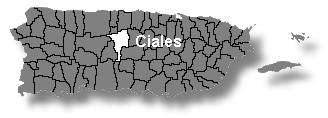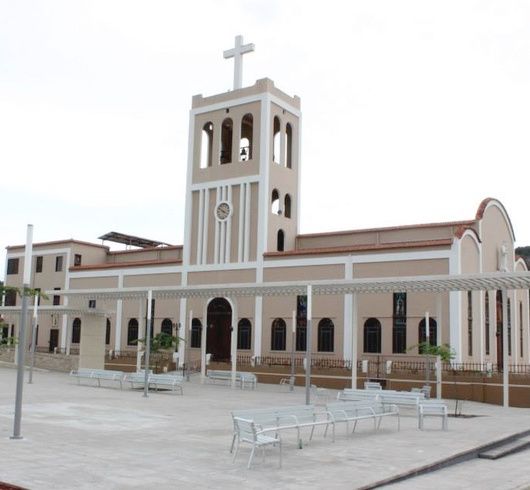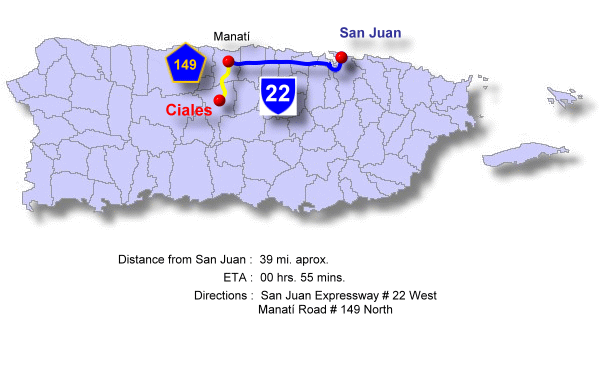
Ciales, Puerto Rico
The Cojoba City

Ciales (see-AH-les) is known as the “cojoba town,” “the land of coffee,” and “the town of the brave. The patron saint is Our Lady of the Rosary.
Ciales is located on the northern side of the Central Mountain Range. It is bordered on the north by Arecibo, Florida and Manatí; on the south by Orocovis; on the east by Morovis and Orocovis; and on the west by Utuado and Jayuya. Three geographic regions converge in the municipality: the humid hills of the North; the humid mountains of the East; and the rainy mountains of the West.
The moderately fertile soil is relatively deep. The terrain is largely mountainous which means that cultivated land is very steep. There is very little flat land, mostly on the eastern side of the town along the Río Grande de Manatí.
Recreational fishing may be practiced in El Guineo Lake, where there are sunfish and large mouth bass.
Ciales economy is largely agricultural, the main crop being coffee. Tobacco and produce are also grown and there is some dairy farming. The government industrial development program has sponsored factories in the town such as, Thermo King de Puerto Rico, the leading manufacturer of refrigerated trailers in the world. Another source of employment is the tobacco factory.
Foundation:
Ciales was founded the 24 of June of year 1820. Before its foundation it had been a district of Manatí. It took the name of Lacy in the beginning, a military hero who stood out in the War of Independence that freed Spain from France.
There’s two other theories proposed for the origin of this name: the nationalist poet Juan Antonio Corretjer says that its origin comes from the Taíno word “saibales” (stone site); others say that it comes from the Celis family that lived in the region. Today the name of Taíno origin is accepted.
After being a district of the municipality of Manatí, Ciales became independent by means of the initiative of its neighbors, who in 1816 solicited authorization to separated the town from Manatí, for the reasons that others adduced in similar cases: distance of the municipal capital, bad conditions or absence of roads, impossibility to attend mass or to receive the sacraments, lack of local justice and other resemblances.
In order to carry out the request they empowered Isidoro Rodríguez Villalobos. After taking declarations of numerous witnesses and other tests, the Provincial Delegation recommended to approve the request and authorize to populate the area.
On November 14, 1820 this Delegation pointed out that the neighbors had already concluded the construction of a church, under the invocation of San José, erected a jail, and had a priest. Initially Ciales had four wards: Alto de la Jagua, Ciales Town, Cuadrillera and Pozas.

Cohoba / Cojoba Tree (Piptadenia peregrina)
The Taíno chiefs inhaled ground “cohoba” seeds, a hallucinogen. Often, tobacco and ground shells were added to the cohoba to enhance its potency. A ritual cleansing, which included carved vomiting sticks, preceded inhaling the hallucinogen.
Cohoba was inhaled into the nose with tubes made from a variety of materials such as bones or tubers. The cacique’s hallucinations were believed to be communication with the various gods.
Location:
 Ciales is located in the northern elevations of the Central Mountain Range (Cordillera Central). It is bordered by: Arecibo, Florida and Manatí on the north, Jayuya, Juana Diaz and Orocovis on the south, Utuado and Jayuya on the west, and Morovis and Orocovis on the east.
Ciales is located in the northern elevations of the Central Mountain Range (Cordillera Central). It is bordered by: Arecibo, Florida and Manatí on the north, Jayuya, Juana Diaz and Orocovis on the south, Utuado and Jayuya on the west, and Morovis and Orocovis on the east.
Area:
171.6 kilometros cuadrados / 66.0 millas cuadradas
Population:
19,811 (census 2000)
Population Density:
115.4 per sq km / 300.1 per sq mi
People are known as:
Cialeños
Ciales is also known as:
La Ciudada de la Cojoba (The Cojoba City)
La Tierra del Café (Land of Coffee)
Pueblo de los Valerosos (Town of Valiants)
Wards: Ciales, Puerto Rico

| Census 2000: Population by Wards – Ciales |
Habitants |
| Ciales Pueblo | 1,211 |
| Cialitos | 1,490 |
| Cordillera | 2,193 |
| Frontón | 2,684 |
| Hato Viejo | 2,444 |
| Jaguas | 4,943 |
| Pesas | 2,067 |
| Pozas | 1,503 |
| Toro Negro | 1,276 |
| Total | 19,811 |
Source: US Censo
Patron:
Nuestra Señora del Rosario
Nuestra Señora del Rosario Parish
P.O. Box 26
Ciales, Puerto Rico 00638-0026
(787) 871-3485
Fundation: 1820
Matron Festivities: October 7
Mass Schedule:
Daily: 6:15am, 7:00am & 6:30pm
Saturday: 7:3Opm | Sunday: 7:30am & 10:00am m

Topography:
It contains medium elevations such as the La Holla, Vista Alegre and Cedro hills.
Hydrography:
The Grande de Manatí river serves as the border with Morovis, its affluents are the Toro Negro, Cialitos, Bauta, Barbas, Ciales, Yunes and De las Yucas rivers.
Economy:
Agriculture; coffee & cattle.
Average Salary:
$285.56 weekly (1998)
Flag:
 During the 150th anniversary of the foundation of Ciales in 1970, the flag, coat of arms and seal were officially adopted. The municipal assembly proclaimed the following, with the sanction of Mayor Don Ismael Nazario and with the backing of resolution No. 13 series 1969-70 among others:
During the 150th anniversary of the foundation of Ciales in 1970, the flag, coat of arms and seal were officially adopted. The municipal assembly proclaimed the following, with the sanction of Mayor Don Ismael Nazario and with the backing of resolution No. 13 series 1969-70 among others:
- To adopt officially the flag, coat of arms and the seal of the municipality
- To celebrate the 150th anniversary of the foundation
- To authorize and delegate the Cultural Center of Ciales the organization of these historical events
The flag is an abstract composition where the colors of the shield are repeated, with the exception of gold that is represented in the flag by yellow. The flag is divided into seven unequal stripes described in sequence: yellow, red, yellow, purple, yellow, red, and yellow. The design is the same as the Vega Alta flag, but with more vivid colours.
Coat of Arms:
 The coat of arms consists of a gold shield with a lion standing on its rear legs and silverplated nails grasping a silver coiled parchment between its front claws. The lion also shows a red tongue. Above the lion in the superior part of the shield are located three heraldic roses arranged horizontally with red petals and green leaves.
The coat of arms consists of a gold shield with a lion standing on its rear legs and silverplated nails grasping a silver coiled parchment between its front claws. The lion also shows a red tongue. Above the lion in the superior part of the shield are located three heraldic roses arranged horizontally with red petals and green leaves.
A golden crown of three towers rests on the shield. The three towers are united by walls, simulating masonry blocks. The shield is surrounded by a crown of coffee tree branches with their berries, all in natural colors.
The butt ends of the branches are tied by a red ribbon and crossed under the shield. Below the shield, a white floating ribbon contains the inscription “LACI-ES” written in black letters.
Places To Visit:
- Caves: Las Golondrinas, Yuyú, and Las Archillas. The latter appears in the history and legends of Ciales.
- Negrón Plantation
- Casa Corretjer Museum and Library
- Coffee Museum
- La Parada Choferil – local food restaurant
- Toro Negro Forest Reserve
Events:
- Corretjer Cantata – March
- Fresh Water Festival –July
- Cliff Festival – July
- Saint Elias Festival – July
- Patron Saint’s Festival in Honor of Our Lady of the Rosary and Saint Joseph the Patriarch – October
Distinguished Citizens:
- Juan Antonio Corretjer – poet, essayist, journalist and pro-independence activist. During the 1930s Corretjer belonged to the Nationalist Party, representing the Party abroad. He was jailed for his political activities in San Juan and then in Atlanta, Georgia. Corretjer published 22 books of poetry and in 1978 the Institute of Puerto Rican Culture published an anthology of his work. He directed the newspaper La Palabra and in the 1950s he was an editorialist at the newspaper El Mundo.
- Carmelo Díaz Soler – musician, arranger, and composer. Díaz had his own band that played at many dances. He also played with the Puerto Rico Symphony Orchestra in 1934 – 1935.
- Antonio J. González – born in Manatí, but raised in Ciales, Gonzalez was an economist, attorney and college professor. He was one of the founders of the Puerto Rican Independence Party (PIP), which was founded in 1946. In 1968, he was candidate for Governor on that party’s ticket. In 1972 he founded the Puerto Rico Union Party and ran as its candidate for Governor.
- Diego O. Marrero – poet
- Miguel Martorell Torrens – representative to the House for District 6 between 1917 and 1920
- Luis A. Miranda – poet, journalist, and essayist. Miranda was a member of the Puerto Rico Academy of the Spanish language.
- Jorge Luis Morales – poet, educator, editor, and essayist. Morales was awarded first prize at the 19th Cultural Olympics held in Mexico City in 1968.
- Antonio Pacheco Padró – journalist, writer, and political figure. A supporter of independence, Pacheco was one of the founders of the Popular Democratic Party in 1940 and served as a Representative to the House for District 26 in 1945 – 46 and 1947 – 48.
- Humberto Padró – story writer, poet, and journalist.
- Jorge Luis Porras Cruz – essayist and educator. Porras headed the Department of Hispanic Studies at the Río Piedras Campus of the University of Puerto Rico.
- Carmen Loreina Santos Silva – poet, writer, and college professor.
- Fernando Sierra Berdecía – journalist, novelist, and playwright.
- Enrique Vicens Sastre – senator-at-large from 1973 to 1978.
- Juan (Pachín) Vicens – during the 1950s and 60s he was an outstanding basketball player. He was on the Puerto Rico national team several times and in 1959 he was elected the best player in the world at the World Games held in Chile. He also competed at the 1964 Olympics in Japan, where Puerto Rico came in fourth.
- Nimia Vicens – poet
Morovis Region
Ciales District
| Name | Level | Telephone | Address |
| Elementary | |||
| CONCEPCIÓN PÉREZ HERNÁNDEZ | K-6 | (787) 871-6090 | PO Box 1433, P.R. 00638-0000 |
| CRISTÓBAL VICENS | K-6 | (787) 871-1002 | PO Box 1391, P.R. 00638-0000 |
| ERNESTO VALDERAS | 4-6 | (787) 871-3165 | PO Box 1436, P.R. 00638-0000 |
| FRANCISCO COIRA | PK-3 | (787) 871-2575 | PO Box 1339, P.R. 00638-0000 |
| HATO VIEJO CUMBRE | K-6 | (787) 871-3616 | PO Box 1391, P.R. 00638-0000 |
| PESA PARCELAS | K-4 | (787) 871-0822 | PO Box 2157, P.R. 00638-0000 |
| REPUBLICA DEL ECUADOR | K-6 | (787) 871-3306 | PO Box 1436, P.R. 00638-0000 |
| ZENÓN RIVERA | K-3 | (787) 871-5006 | PO Box 2157, P.R. 00638-0000 |
| Intermediate | |||
| JUAN RÍOS SERPA | 7-9 | (787) 871-3225 | PO Box 3802, P.R. 00638-3802 |
| Secondary | |||
| SU FRANCISCO SERRANO | 4-9 | (787) 871-3385 | PO Box 1431, P.R. 00638-0000 |
| SU JAIME COIRA | K-9 | (787) 871-4692 | PO Box 1421, P.R. 00638-1421 |
| SU TORIBIO RIVERA | K-9 | (787) 871-4738 | PO Box 1361, P.R. 00638-0000 |
| High School | |||
| JUAN A. CORRETJER | 10-12 | (787) 871-5405 | PO Box 1419, P.R. 00638-0000 |
Hymn:
By Jesús Roure Pérez & Radamés Pagán Pérez
El cantar de tus ríos es mensaje
de tu origen ibero y viril
que orgullosos tus hijos ostentan
en las lides del diario vivir.
Y en tus sendas que adornan luceros
se engalanan con la tradición
que revive en tu historia las huellas
del criollo su fe y su dación.
En tus montes florece el cafeto
y en tus valles se yergue la palma
con su inhiesto penacho hacia el cielo
en ruego por la patria y las almas.
Y en Frontón, Cordillera y Bateyes
aún resuena del indio el tambor
recordando a tus hijos como muere
el boricua con dignidad y honor.
Ciales, Oh pueblo mío
cuna donde nací
de tus hijos orgullo,
de la Patria un jardín
de la Patria un jardín
Ciales, Oh cuna amada
en ti quiero morir
escuchando tus ríos
y el cantar del coquí
y el cantar del coquí
Tu bandera y tu escudo eternizan
los valores que haz dado a la Patria
y tu nombre es sencilla diadema
que en tus hijos el pecho engalana
Y en tu historia hay páginas de oro
que escribieron el blanco y el negro
que en tu nombre juramos honrar
cual cialeños y puertorriqueños.

